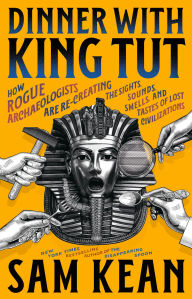My Gripe with Archaeology: A Guest Post by Sam Kean
Fascinating, fulfilling and, above all else, fun. This utterly eye-opening (and nose- and mouth-opening) exploration of the history of practically everything is an enriching and endlessly entertaining journey. Read on for an exclusive essay from author Sam Kean on writing Dinner with King Tut.
Dinner with King Tut: How Rogue Archaeologists Are Re-creating the Sights, Sounds, Smells, and Tastes of Lost Civilizations
Dinner with King Tut: How Rogue Archaeologists Are Re-creating the Sights, Sounds, Smells, and Tastes of Lost Civilizations
By Sam Kean
In Stock Online
Hardcover
$29.50
$32.50
From “one of America’s smartest and most charming writers” (NPR), an archaeological romp through the entire history of humankind—and through all five senses—from tropical Polynesian islands to forbidding arctic ice floes, and everywhere in between.
From “one of America’s smartest and most charming writers” (NPR), an archaeological romp through the entire history of humankind—and through all five senses—from tropical Polynesian islands to forbidding arctic ice floes, and everywhere in between.
I’ve always had a gripe with archaeology. On the one hand, it seemed like the most thrilling field in science—able to illuminate the history of humankind in a way no other discipline could. On the other hand, whenever I visited an archaeological dig, my shoulders sagged in disappointment. The work looked so … dull. Just scores of sunburned people sprawled in the dirt, dusting off pot shards with toothbrushes. There was such a disconnect between the stirring conclusions the field reached and the monotony of the daily grind.
Imagine my delight, then, when I discovered experimental archaeology
Experimental archaeologists do things—actively recreate the past, in all sorts of ways. They make human mummies. They brew Viking beer and bake the tangy sourdough bread that King Tut ate. They drive Roman chariots and build rickety ships and plunge out onto the open sea with all the verve of Indiana Jones. I especially loved how sensory-rich the field is—you actually get to hear and smell and taste exactly what our ancestors did. Some people call the field not experimental archaeology but living archaeology.
Each chapter of Dinner with King Tut recreates a day in the life of one of our ancestors, and my research took me across the globe, from the Andes to the Arctic to remote Polynesian islands. In each case, I’d prepare ahead of time by reading all I could about the history and people of the region. Then I’d arrive, and throw myself into some experimental archaeology project there. At one stop, I fired a giant medieval catapult. At another, I played an ancient Aztec ballgame. I also performed primitive neurosurgery; got—and gave—my first tattoo, with hand-poked needles; helped prepare an authentic Roman banquet; and ate everything from walrus to acorns to caterpillars.
For the most part, I proved comically inept at these tasks. (Minus the eating; I’ve got that down.) But that was half the fun of the book—me floundering around, getting bruises in places I never even imagined could bruise, or getting splattered with urine, blood, brain goo, blubber oil, or worse. More importantly, my failures taught me important lessons about how difficult life really was way back when. Even preparing a simple meal could take hours, not to mention finding clothing or shelter. It’s one thing to know about these difficulties abstractly, quite another to feel the sheer exhaustion of some task in your bones, or feel frustration over it roiling inside your chest.
But it was all worth it. Even (or especially) when floundering around, I learned a vast amount about ancient life. It was like running my fingers over a flat surface and suddenly feeling a third dimension ripple up. Writing this book made the people of ancient Rome and Africa and Polynesia and Egypt come alive for me in ways they never had before, and keeps them alive for me now. The stories in Dinner with King Tut are instructive and fun, but they’re also a form of time-travel—passing traditions down, connecting one generation to the next. Indeed, they’re as close to time-travel as we humans can ever hope to get…

